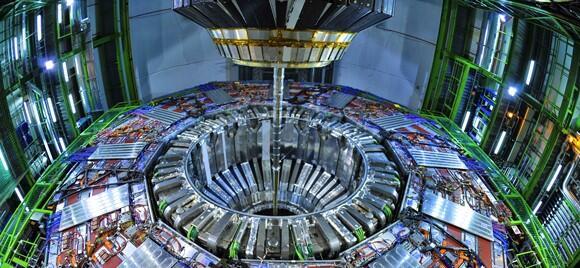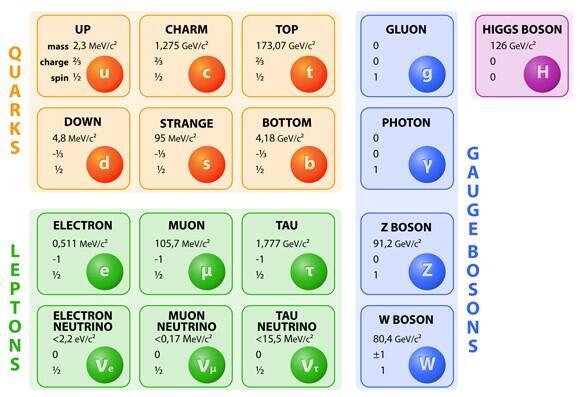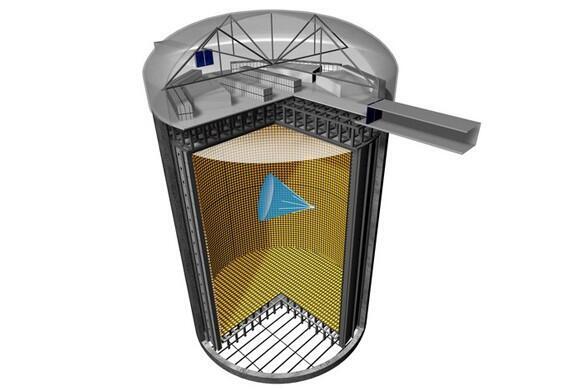For thousands of years, people have sought to understand the true nature of the world: what is everything made of? How do particles compose the whole that we see? Physicists have diligently worked to uncover layer after layer of this mystery, and in the 1970s, they compiled a detailed theory known as the Standard Model of particle physics.
The Standard Model describes a diverse array of particles and is considered one of the most accurate and successful theories ever formulated. Particle accelerators worth billions of dollars, such as the Large Hadron Collider at CERN in Switzerland, were constructed to test and further develop the Standard Model. So far, the model has withstood every test. Nevertheless, the physics community acknowledges that the Standard Model is incomplete and does not describe the world with full accuracy.
4 View gallery


The largest particle accelerator in the world cost billions of dollars to construct. A detector in the particle accelerator at the CERN research center in Switzerland
(Photo: D-VISIONS, Shutterstock)
Constructing the model
The Standard Model is a physical model based on quantum field theory, a physical theory framework developed during the early twentieth century that unites the principles of special relativity with those of quantum mechanics. In the realm of physics, a field is a mathematical object assigning a value to each point in space. A familiar analogy from everyday life is the temperature field: at each point in our world, there is a numerical value representing the temperature at that specific location. A field can contain more complex information than a single number per location.
Consider a field of wind velocity, where each location is assigned a number and a direction—vector, in mathematical terms—indicating the strength and direction of the wind at that point. Descriptions of more intricate fields, such as particle fields describing particle behavior, may involve additional mathematical complexities but adhere to the same underlying principle.
According to the Standard Model, our universe is composed of an array of fields that, when excited, give rise to what we call particles. You can think of each field as a tranquil sea and particles as the waves: emerging from the sea and eventually dissipating back into it.
Beyond fields, the Standard Model assumes the existence of specific symmetries. In a mathematical and physical context, symmetry denotes an operation that leaves a system unchanged.
The simplest assumption is that the laws of physics are symmetrical and do not change if we turn the universe upside down—that is, they are independent of the orientation from which one studies them. Our world has no preferred direction. The Standard Model upholds several symmetries, most of which are too complex to describe non-mathematically, but they largely define the model's behavior.
In the early twentieth century, Jewish mathematician Emmy Noether discovered that if the laws of nature for a physical system are fixed in time—or, in physical terms, symmetrical for time shifts—the system must uphold the law of conservation of energy. If a theory upholds symmetry, there must be a conservation law, meaning the system has physical quantities that remain constant.
For example, many of the quantities we use to describe the world are expressions of conservation laws, like energy or momentum. The symmetry inherent in the Standard Model yields additional conservation laws, including the conservation of electric charge.
When trying to use the model to represent more complicated symmetries, which do not always have simple physical interpretations, we must "pay a price." To represent these symmetries, we will have to sacrifice certain processes, introduce new particles, or alter the physical properties of existing particles. Ultimately, understanding which symmetries the model upholds and which fields it includes, provides all the information needed about the model.
4 View gallery


Each field can be likened to a tranquil sea and particles to waves. A quiet and wavy sea
(Photo: Sergioboccardo, Shutterstock)
Collecting the particles
We've gained a little insight into how to construct the Standard Model. But what does it comprise? Broadly, the Standard Model comprises 24 particles classified under the Fermions family and 13 particles classified as the Boson family. Fermions and bosons generally differ in their quantum properties, particularly in a property known as spin.
In the context of the Standard Model, fermions are commonly regarded as "matter" particles, while bosons are considered "force carriers." According to the model, bosons are the particles that should be used to uphold complex symmetries, as previously explained.
The bosons of the Standard Model carry three of the four fundamental forces. Their movements and interactions with other particles are what we interpret as the actions of these forces. The first boson, and perhaps the most commonly familiar boson, is the photon, which is the particle that carries the electromagnetic force. Additionally, there are three bosons that carry the weak nuclear force (W+, W-, and Z) and eight bosons that carry the strong nuclear force, called gluons. The last boson, which is the most recent piece of the Standard Model to be discovered, is the Higgs boson.
Named after Peter Higgs, one of the scientists who predicted its existence in the 1960s, the Higgs boson was finally discovered in CERN’s Large Hadron Collider, and some of the researchers who predicted its existence were awarded the Nobel Prize in Physics a year later. The Higgs boson is not associated with a specific force, but through a mechanism called “symmetry breaking,” the Higgs particle imparts mass to other particles in the theory. In the Standard Model, there is no boson that carries the force of gravity, which we will discuss later.
Fermions constitute the Model’s matter particles and are divided into two categories: Quarks and Leptons. All known matter is a composite of these particles, with no particles more elementary discovered thus far. The Standard Model includes six quarks, which differ in their electric charge and mass, and they have amusing names.
The positively charged quarks are called— from lightest to heaviest— are named Up, Charm, and Top, while the negatively charged quarks are named Down, Strange, and Bottom. Quarks interact with each other via the strong nuclear force, the weak nuclear force, or the electromagnetic force, and they compose the nuclei of atoms: a proton is made of two Up quarks and one Down quark, while a neutron is made up of two Down quarks and one Up quark.
There are many types of quarks, but no quarks heavier than Up and Down quarks can be naturally found. Why? Because particles with higher masses are unstable. After forming, they quickly turn into lighter particles, or in physical terms - they undergo decay. The only places where it is likely to find heavier quarks, sometimes referred to as “generations” or “flavors,” are in particle accelerators or, according to certain theories, within neutron stars.
In addition to quarks, the Standard Model also includes leptons, which, unlike quarks, do not interact with other particles via the strong nuclear force. These particles include the familiar electron, and other particles - the muon and tau, which carry a similar charge but have larger masses. Like quarks, the heavier leptons are hard to find in nature as they rapidly decay into more stable particles, such as electrons.
In addition to these particles, there are three leptons called neutrinos - electron neutrino, muon neutrino, and tau neutrino. According to the model, these particles have no electric charge and no mass and play a key role in processes related to the weak nuclear force, such as radioactive decay.
Each fermion has a twin, its antiparticle, which is identical in almost every property. The electric charge of the antiparticle is opposite to that of its particle twin, and there are other differences related to the weak and strong nuclear forces. For example, the antiparticle of the electron, called the positron, has a charge of the same magnitude but it is opposite in sign (positive, in contrast to the negative electron). Similarly, each of the other leptons and quarks has a corresponding antiparticle.
To summarize, the Standard Model includes 13 bosons—photons, two Z bosons, W bosons, eight gluons, and the Higgs boson - and 24 fermions - six quarks, six antiquarks, six leptons, and six antileptons, totaling 37 particles. It is remarkable that we can describe nearly everything that composes our world in a relatively simple framework: 37 particles, three forces, and a few symmetries.
The most accurate measurement performed by physicists is that of the magnetic moment of the electron, which quantifies how an electron reacts to magnetic fields in its vicinity. The magnetic moment of the electron was measured with a relative error of one millionth of a millionth of a percent, resulting in a value that perfectly aligns with the Standard Model’s predictions.
4 View gallery


Bosons, quarks and leptons. The particles that compose the Standard Model
(Photo: Designua, Shutterstock)
Going beyond standard
We have learned a lot about the Standard Model and claimed that it provides us with the most accurate predictions we have ever been able to confirm. The problem is that the Standard Model is incomplete and even wrong in some aspects. The current consensus is that it should be expanded or replaced. Why?
The Standard Model has several major problems. The most prominent issue is that the model does not include a description of the fourth force in nature—gravity. The reason for this lies in the mathematical complexities that arise when trying to link quantum field theory with general relativity. Some have attempted to solve this difficulty using complex physical theories such as string theory. In any case, the Standard Model includes no boson that accounts for gravity, though other theories predict its potential properties, such as its spin and its mass.
Additionally, according to the Standard Model, neutrino particles are massless. However, in the early 2000’s evidence has emerged that neutrinos do have mass (though very small) - a discovery that earned the researchers Takaaki Kajita and Arthur B. Mcdonald the 2015 Nobel Prize in Physics. While it is possible to modify the model to include mass for neutrinos, the underlying question remains: why does the original Standard Model describe neutrinos as massless? The common conception among physicists is that the model's base assumptions should be amended rather than merely resorting to ad hoc modifications.
Another problem is that the Standard Model does not account for the existence of dark matter. Dark matter is a name for matter that neither emits or absorbs electromagnetic radiation, and, therefore, cannot be seen. Current observations estimate that about eighty percent of the matter in the universe is dark matter, though some physical theories suggest otherwise.
The properties of dark matter are unknown, and it is not included in the Standard Model. Many scientists attempt to predict possible elementary particles that could explain the properties of dark matter and conduct experiments to validate or refute these theories. Thus far, no prevailing or definitive theory has successfully integrated dark matter into the Standard Model.
4 View gallery


Contrary to the predictions of the Standard Model, neutrino particles have mass. Neutrino detector at the Super Kamiokande facility in Japan
(Illustration: Paul Wootton, Science Photo Library)
The cracks in the model
The Standard Model leaves certain questions unanswered, compelling physicists to seek explanations. One example is the matter-antimatter asymmetry: as mentioned earlier, every particle has a twin, an antiparticle, with an opposite electric charge. However, for some reason, the universe predominantly comprises matter. The Standard Model postulates symmetry between matter and antimatter, with no reason for the world to be composed solely of one and not the other. Why, then, does this asymmetry exist in practice?
Another issue, the hierarchy problem, pertains to the Higgs boson. To simplify, the mass of the Higgs boson depends on the outcome of two processes. Each of these processes yields a very large numerical value, and the discrepancy between these values is precisely the number needed for the Standard Model to "work." While not inherently indicating flaws within the Standard Model, these discrepancies trouble physicists striving for a comprehensive understanding of the universe, one that leaves no room for uncertainty. Scientists addressing this issue seek to uncover whether an underlying mechanism exists that dictates the outcomes of the processes related to the hierarchy problem and links them together
Many physicists across the globe strive to refine and rectify the Standard Model. Part of this effort, particularly in experimental particle accelerators, are devoted to the search for discrepancies between the Standard Model's predictions and empirical observations, as these gaps would offer researchers insights into fundamental flaws in the model. Such discrepancies have been found in recent years, such as variations between the predicted and measured magnetic moment of the muon, disparities in process probabilities versus experimental outcomes, and more. To date, none of these experiments have achieved the level of certainty required in high-energy particle physics—99.9999%, or a one-in-a-million chance of error. Achieving such certainty would enable physicists to to delve deeper into the underlying process and potentially pinpoint the origin of discrepancies within the model.
This is the Standard Model, these are the problems with it, and these are some of the efforts to find errors in it. Scientists struggle to find additional discrepancies in the model, partly because the energies required to confirm or refute many of the predictions are much higher than those attainable with today's particle accelerators.
The Standard Model stands as one of the paramount achievements of 20th-century physics and science in general. It has revealed many layers of our world and yielded astonishing predictions. However, the entire physics community persists in its quest to identify and rectify the model’s shortcomings, eagerly anticipating the moment when its imperfections are laid bare.

